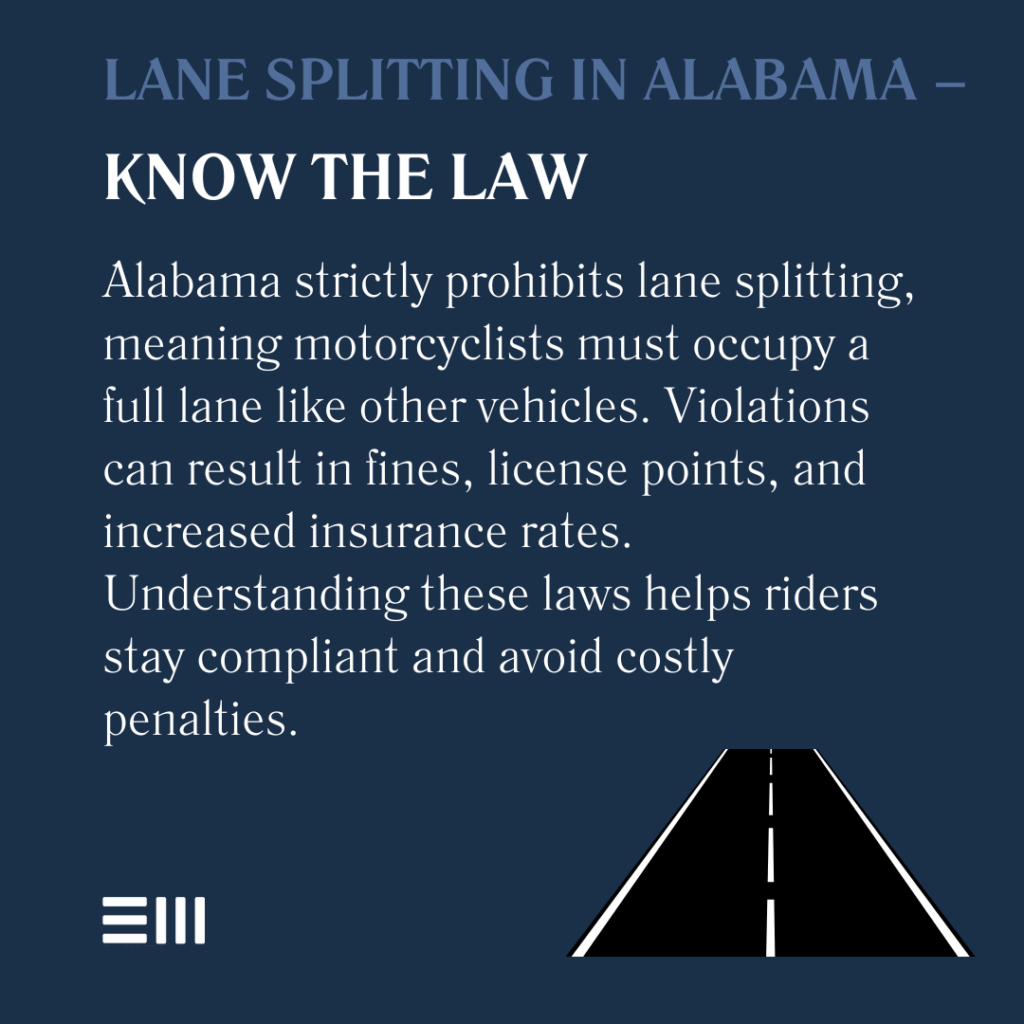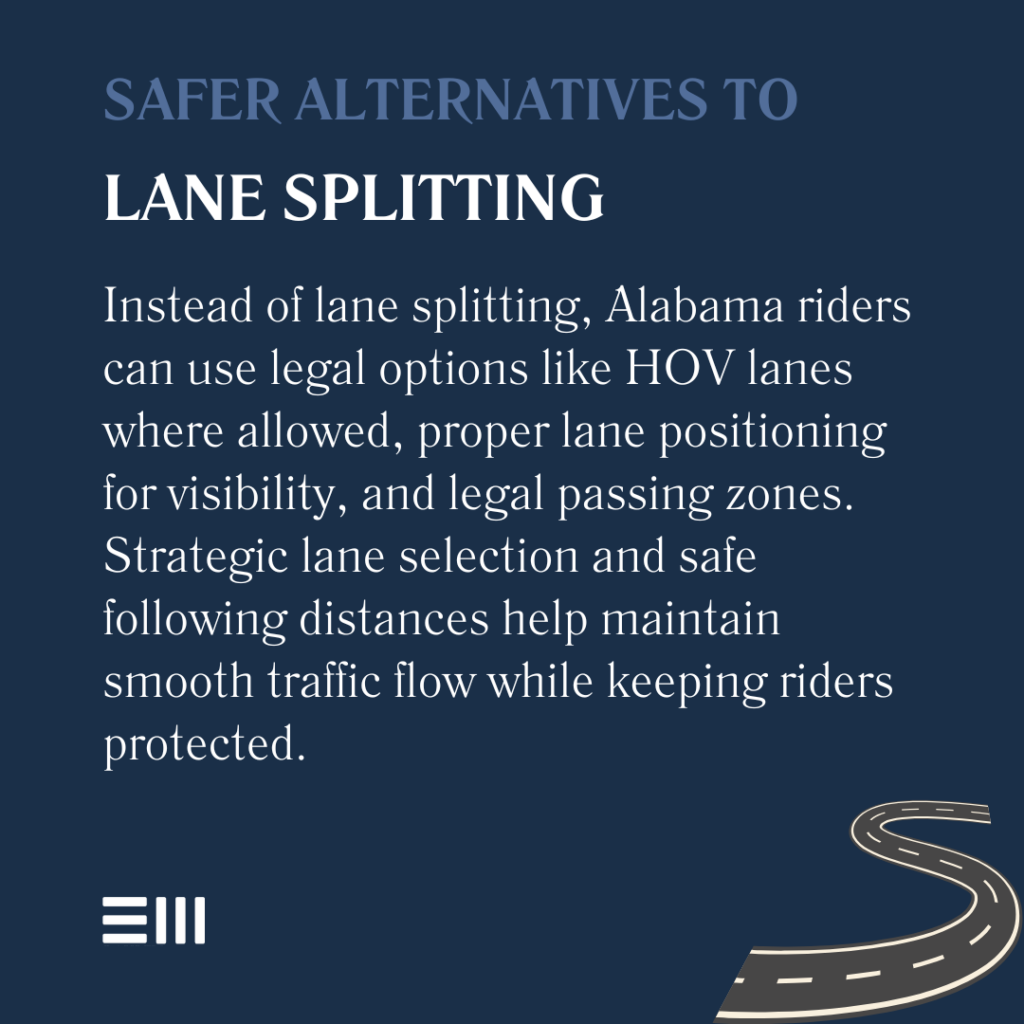
Between the rows of cars gridlocked in Alabama traffic, motorcyclists face a tempting possibility—the open space between lanes beckons as a potential escape route.
While riders in California freely weave between vehicles, Alabama motorcyclists navigate different legal terrain.
Understanding these laws protects both riders’ legal rights and everyone’s safety on the road.
The choices riders make in traffic can impact not only their legal standing but also their insurance coverage and future riding privileges.
Current Lane Splitting Laws in Alabama
Alabama’s stance on lane splitting impacts both daily commuters and recreational riders throughout the state.
The legal framework shapes how motorcyclists must navigate traffic situations and affects their daily riding decisions.
- Lane splitting is explicitly prohibited under Alabama traffic laws (Section 32-5A-82);
- No exceptions exist for heavy traffic or emergency situations;
- Motorcyclists must occupy a full lane, just like other vehicles;
- Riding between lanes or rows of vehicles violates state traffic code;
- Penalties include fines and potential license points;
- Law enforcement actively enforces these restrictions;
- Both moving and stationary traffic rules apply;
- Restrictions cover all types of motorcycles and motor-driven cycles;
- Rules apply on all public roads and highways; and
- Private property restrictions may vary but generally follow state guidelines.
These regulations aim to maintain clear traffic patterns and prevent accidents on Alabama roads while ensuring consistent traffic flow management.

Penalties for Lane Splitting in Alabama
Understanding the consequences of lane splitting helps riders make informed decisions about their road behavior.
Alabama law enforcement takes several actions against those who violate lane splitting prohibitions, with penalties varying based on circumstances and prior violations.
- First offense traffic citations ranging from $100 to $200;
- Second offense fines increasing to $200 to $300;
- Points added to driving record (2-4 points depending on circumstances);
- Increased insurance premiums lasting 3-5 years;
- Potential license suspension for repeat offenses (three violations within 24 months);
- Civil liability in case of accidents;
- Required traffic safety courses for point reduction;
- Additional court costs and fees;
- Possible vehicle impoundment in severe cases;
- Impact on commercial driving privileges;
- Mandatory court appearances in some jurisdictions; and
- Enhanced penalties if violations occur in construction zones.
These penalties reflect Alabama’s commitment to maintaining specific traffic patterns for all vehicles and ensuring road safety.
Safety Considerations and Statistics
The debate around lane splitting involves significant safety factors that affect both motorcyclists and other vehicles.
Research and real-world experience reveal important safety implications that every rider should consider.
- Limited visibility for car drivers checking blind spots;
- Reduced reaction time in emergency situations;
- Weather impacts on safe maneuvering space;
- Speed differential risks between vehicles;
- Road condition effects on motorcycle stability;
- Impact of vehicle size variations;
- Night riding visibility concerns;
- Emergency vehicle access considerations;
- Pedestrian crossing risks;
- Intersection visibility issues;
- Construction zone hazards;
- Multi-lane highway dynamics;
- Urban vs. rural road differences;
- Traffic pattern unpredictability; and
- Impact of distracted drivers.
These safety factors influence both legal standards and practical riding decisions in Alabama’s diverse road conditions.
Alternative Legal Riding Practices
While lane splitting remains prohibited, Alabama motorcyclists have several legal options for navigating traffic efficiently.
These alternatives provide safe and legal ways to manage traffic situations while maintaining compliance with state laws.
- Using HOV lanes where permitted during designated hours;
- Proper lane positioning within marked lanes for maximum visibility;
- Legal passing in designated zones with adequate spacing;
- Utilizing shoulder stops during emergencies or mechanical issues;
- Following proper merging procedures in heavy traffic;
- Maintaining safe following distances appropriate for speed;
- Strategic lane selection based on traffic flow;
- proper spacing between vehicles;
- Using turn lanes appropriately;
- Defensive positioning techniques;
- Group riding protocols;
- Emergency maneuver options;
- Traffic signal navigation strategies; and
- Peak hour travel alternatives.
These practices help riders navigate traffic while staying within legal boundaries and maintaining safety.

Motorcycle Safety Equipment Requirements
Along with lane positioning rules, Alabama maintains specific requirements for motorcycle safety equipment that affect how riders can operate their vehicles.
- DOT-approved helmets mandatory for all riders;
- Eye protection requirements;
- Proper lighting equipment;
- Mirror positioning rules;
- Brake light requirements;
- Turn signal specifications;
- Muffler and noise restrictions;
- Handlebar height limitations;
- Passenger seating regulations;
- Footrest requirements;
- Chain guard specifications; and
- Tire tread depth minimums.
Compliance with these requirements supports safe riding practices and legal operations.
Comparing Lane Splitting Laws Across States
Alabama’s approach to lane splitting fits within a broader national context of motorcycle laws.
Different states take varying approaches to this practice.
- California: Only state with legal lane splitting;
- Utah and Montana: Allow similar “lane filtering” at stops;
- Texas: Explicitly prohibits the practice;
- Florida: No specific law, but generally prohibited;
- Georgia: Similar restrictions to Alabama; and
- Mississippi: Follows traditional lane usage requirements.
Understanding these variations helps contextualize Alabama’s stance on lane splitting.
Common Questions About Lane Splitting in Alabama
Motorcyclists often seek clarity about lane-splitting rules and their practical application in Alabama.
Here are detailed answers to frequent concerns.
What Exactly Constitutes Lane Splitting?
Lane splitting involves riding a motorcycle between lanes or rows of stopped or moving vehicles. This includes moving between lanes at traffic lights or during congestion.
How Does Alabama Define Legal Lane Position?
Motorcycles must maintain a full lane position centered within the lane, just like cars and trucks. Sharing lanes or riding on lane markers violates state law.
What if Traffic Is Completely Stopped?
Even in standstill traffic, motorcycles must maintain their lane position. No exceptions exist for heavy congestion or stopped traffic.
Do Emergency Situations Allow Lane Splitting?
Emergency vehicles have specific exemptions, but private motorcycles must follow standard lane usage rules even in urgent situations.
How Does Insurance Handle Lane Splitting Accidents?
Insurance companies may deny claims involving lane splitting, as it constitutes illegal operation of a motorcycle in Alabama.
Secure Your Legal Rights on the Road
Navigating motorcycle laws and accidents requires experienced legal guidance.
Whether dealing with traffic citations or accident claims, understanding your rights makes a crucial difference in protecting your riding privileges and legal interests.
Contact Baxley Maniscalco today for expert motorcycle law consultation.
Our experienced team understands Alabama’s motorcycle regulations and fights for riders’ rights.
Can't find what you're looking for? Search our site below.










